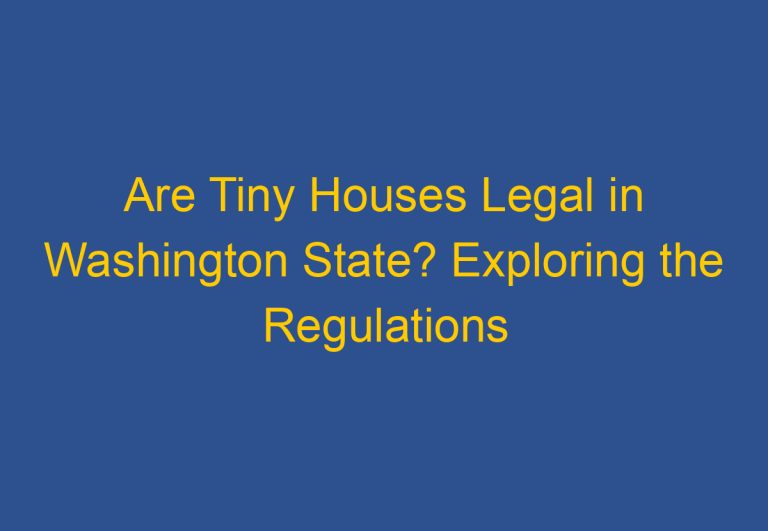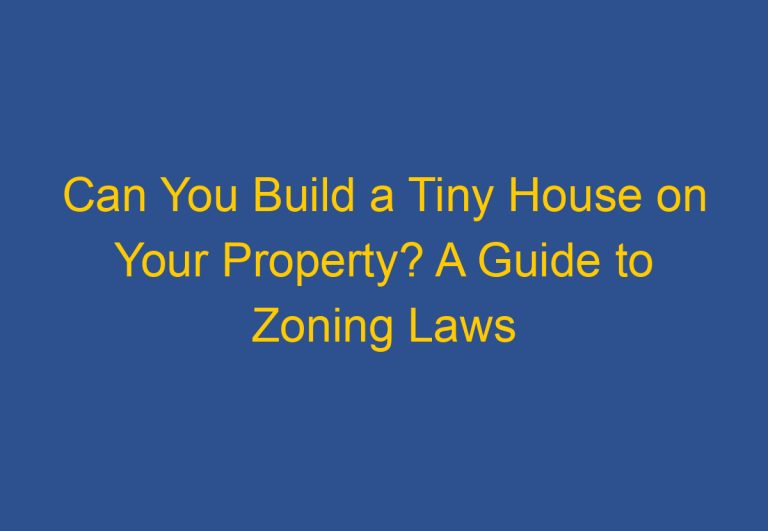Where Can I Live in a Tiny House: Finding the Perfect Location
The tiny house movement is a growing trend that has been gaining popularity over the years. More and more people are becoming interested in downsizing their living space and simplifying their lifestyle. However, one of the biggest questions that people have when it comes to tiny living is, “Where can I live in a tiny house?”

Living in a tiny house presents a unique set of challenges when it comes to finding a place to call home. Zoning laws, building codes, and other regulations can make it difficult to find a suitable location for your tiny house. However, with a little bit of research and some creative thinking, it is possible to find a place to live that is both legal and comfortable.
There are a variety of options available for those looking to live in a tiny house. Some people choose to live in tiny house communities, where they can enjoy the company of like-minded individuals and share resources. Others choose to purchase their own land and build their tiny house there. Whatever your preference may be, it is important to do your research and make sure that you are following all applicable laws and regulations.
Understanding Tiny House Living

Living in a tiny house is a unique experience that requires a different perspective on life. It is a lifestyle that is becoming increasingly popular as people seek financial freedom, minimalism, and a simpler way of living. Here are some important considerations to keep in mind when considering tiny house living.
Legal Considerations and Zoning Laws
Before building a tiny house, it is important to research the legal considerations and zoning laws in your area. Different states and cities have different regulations regarding the minimum square footage, foundation requirements, and building codes. The American Tiny House Association is a great resource for information on zoning laws and building codes.
Design and Space Optimization
Design and space optimization are crucial when living in a tiny house. Every inch of space should be utilized efficiently, and storage solutions should be creative and functional. Lofts and stairs are popular design features in tiny houses, as they allow for vertical space to be utilized. Foldable furniture and multi-purpose items are also great space-saving solutions.
Lifestyle and Community
Living in a tiny house requires a significant downsizing of possessions and a change in lifestyle. It is important to consider the community aspect of tiny house living, as many tiny house communities offer shared resources such as community gardens and outdoor spaces. Living in a tiny house also allows for a closer connection to nature and the outdoors.
Location and Placement
Location and placement are important considerations when living in a tiny house. Backyard placement is a popular option for those who want to stay close to family and friends. RV parks and tiny house communities also offer placement options. Lakeside or nature locations are also popular choices for those seeking a more secluded and peaceful lifestyle.
Financial Aspects
Tiny house living can offer financial freedom and a more affordable way of living. Financing options for tiny houses can vary, and it is important to research options such as mortgages or personal loans. Budgeting and financial planning are also important aspects of tiny house living.
Sustainability and Eco-Friendliness
Living in a tiny house can also be a sustainable and eco-friendly lifestyle choice. Using recycled materials and off-grid options can reduce the carbon footprint of tiny house living. Natural materials and energy-efficient appliances can also contribute to a more eco-friendly lifestyle.
Overall, living in a tiny house requires a unique perspective on life and a willingness to embrace a simpler lifestyle. By considering legal considerations, design and space optimization, lifestyle and community, location and placement, financial aspects, and sustainability and eco-friendliness, one can make an informed decision about whether tiny house living is the right choice for them.
Acquiring a Tiny House

When it comes to acquiring a tiny house, there are a few things to consider. First, you need to decide whether you want to build your own or buy one that’s already been built. Building your own tiny house can be a great way to customize the space to your specific needs and preferences, but it can also be time-consuming and require a lot of planning. On the other hand, buying a pre-built tiny house can be a quicker and easier option, but you may have less control over the design and layout.
Building vs. Buying
If you decide to build your own tiny house, you’ll need to consider things like the location, foundation, and stairs. You’ll also need to think about the size of the space and how you’ll make the most of every square foot. If you’re not comfortable with DIY projects, you may want to consider hiring someone to build the tiny house for you.
If you decide to buy a pre-built tiny house, you’ll need to consider things like the square footage, amenities, and financing. You may also want to look into the different types of tiny houses available, such as those on trailers or those that are stationary.
Finding the Right Spot
Once you have your tiny house, you’ll need to find the right spot to park it. This can be a challenge, as zoning laws and regulations can vary from place to place. You may want to consider looking for tiny house communities or RV parks that allow tiny houses. Alternatively, you may be able to park your tiny house on a friend or family member’s property, or even in your own backyard.
Utilities and Maintenance
Living in a tiny house can require some adjustments when it comes to utilities and maintenance. You’ll need to think about things like water, electricity, and waste management. You may also need to be prepared to do some regular cleaning and maintenance to keep your tiny house in good condition.
Living Full-Time vs. Vacationing
Another thing to consider is whether you want to live in your tiny house full-time or use it as a vacation home. If you’re planning to live in your tiny house full-time, you’ll need to think about things like storage, organization, and making the space feel like home. If you’re using your tiny house as a vacation home, you may want to focus more on amenities and entertainment options.
Adjusting to Tiny House Dimensions
Living in a tiny house can require some adjustments when it comes to space and dimensions. You may need to get creative with storage solutions and find ways to make the most of vertical space. You may also need to adjust to a smaller kitchen and bathroom.
Financing and Loans
If you’re buying a pre-built tiny house, you’ll need to think about financing and loans. You may be able to find financing options specifically for tiny houses, or you may need to look into personal loans or other financing options.
Amenities and Essentials
When it comes to amenities and essentials, you’ll need to think about things like heating and cooling, cooking and food storage, and bathroom facilities. You may also want to consider things like a community garden or clubhouse.
Types of Tiny Houses
There are many different types of tiny houses available, from those on trailers to those that are stationary. You may want to consider the pros and cons of each type and think about which one will work best for your needs and lifestyle.
Overall, acquiring a tiny house can be a great way to simplify your life and reduce your carbon footprint. With some careful planning and consideration, you can find the perfect tiny house for your needs and start living your dream of a minimalist lifestyle.
Frequently Asked Questions

What are the zoning regulations for tiny houses in various states?
Zoning regulations for tiny houses vary from state to state. Some states have strict regulations that make it difficult to legally place a tiny house on land, while others have more relaxed regulations. It is important to research the zoning regulations in your state before purchasing a tiny house or land to place it on.
Can I legally place a tiny house on my own property?
The legality of placing a tiny house on your own property depends on the zoning regulations in your area. In some areas, it is legal to place a tiny house on your property as a primary residence, while in others, it may only be allowed as an accessory dwelling unit. It is important to research the regulations in your area before making any decisions.
Which states have the most accommodating laws for tiny house living?
Some states have more accommodating laws for tiny house living than others. States like Colorado, Oregon, and California have more relaxed regulations and are considered to be more friendly towards tiny house living. However, it is important to research the specific regulations in your area before making any decisions.
How do I find communities dedicated to tiny house living?
There are many communities dedicated to tiny house living throughout the United States. Some communities are specifically designed for tiny houses, while others are more general communities that allow tiny houses. Researching online and networking with other tiny house enthusiasts can help you find communities in your area.
What are the typical costs associated with placing a tiny house on land?
The costs associated with placing a tiny house on land can vary depending on a number of factors, including the cost of the land, the cost of the tiny house, and any fees associated with zoning regulations and permits. On average, it can cost anywhere from $25,000 to $150,000 or more to place a tiny house on land.
Are there any areas offering incentives or free land for tiny house residents?
Some areas offer incentives or free land for tiny house residents, but these opportunities are rare. It is important to research the specific opportunities in your area and to be aware that there may be restrictions and regulations associated with these offers.






